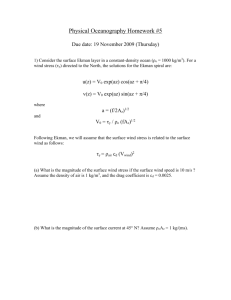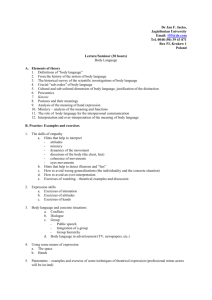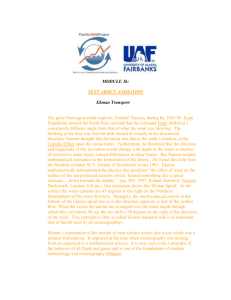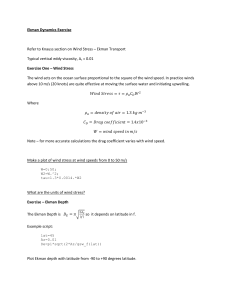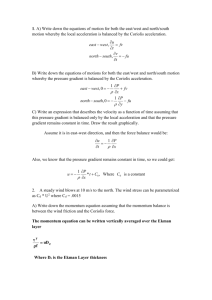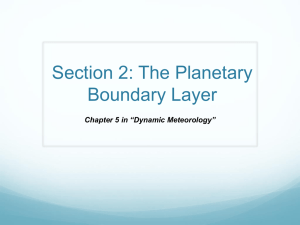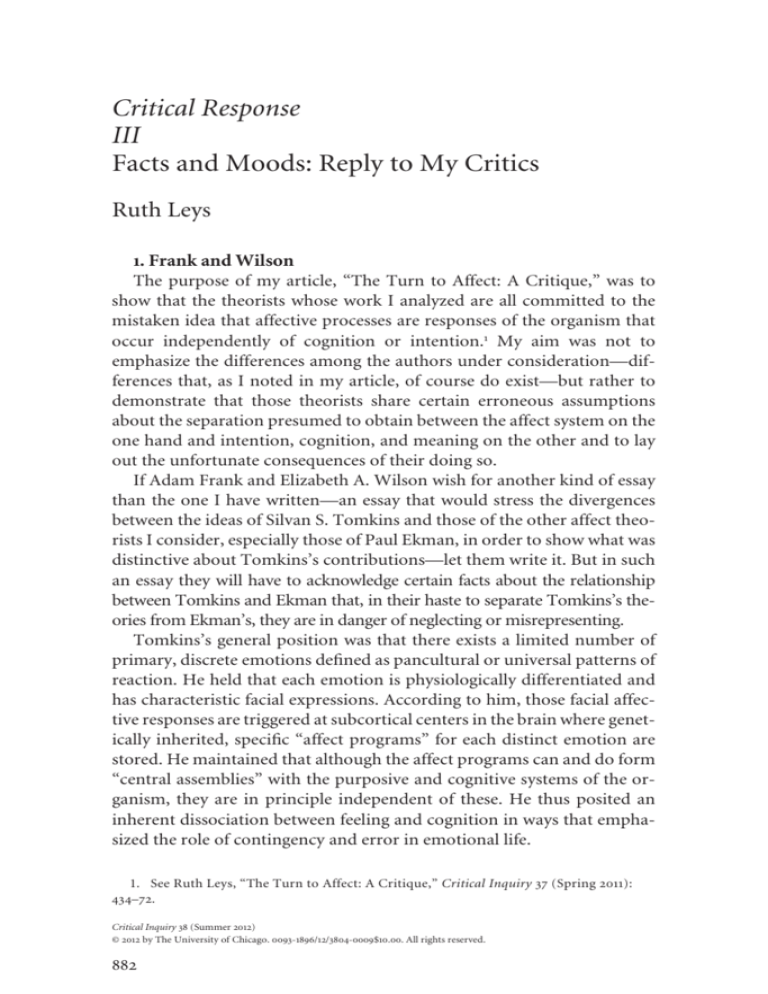
Critical Response
III
Facts and Moods: Reply to My Critics
Ruth Leys
1. Frank and Wilson
The purpose of my article, “The Turn to Affect: A Critique,” was to
show that the theorists whose work I analyzed are all committed to the
mistaken idea that affective processes are responses of the organism that
occur independently of cognition or intention.1 My aim was not to
emphasize the differences among the authors under consideration—differences that, as I noted in my article, of course do exist—but rather to
demonstrate that those theorists share certain erroneous assumptions
about the separation presumed to obtain between the affect system on the
one hand and intention, cognition, and meaning on the other and to lay
out the unfortunate consequences of their doing so.
If Adam Frank and Elizabeth A. Wilson wish for another kind of essay
than the one I have written—an essay that would stress the divergences
between the ideas of Silvan S. Tomkins and those of the other affect theorists I consider, especially those of Paul Ekman, in order to show what was
distinctive about Tomkins’s contributions—let them write it. But in such
an essay they will have to acknowledge certain facts about the relationship
between Tomkins and Ekman that, in their haste to separate Tomkins’s theories from Ekman’s, they are in danger of neglecting or misrepresenting.
Tomkins’s general position was that there exists a limited number of
primary, discrete emotions defined as pancultural or universal patterns of
reaction. He held that each emotion is physiologically differentiated and
has characteristic facial expressions. According to him, those facial affective responses are triggered at subcortical centers in the brain where genetically inherited, specific “affect programs” for each distinct emotion are
stored. He maintained that although the affect programs can and do form
“central assemblies” with the purposive and cognitive systems of the organism, they are in principle independent of these. He thus posited an
inherent dissociation between feeling and cognition in ways that emphasized the role of contingency and error in emotional life.
1. See Ruth Leys, “The Turn to Affect: A Critique,” Critical Inquiry 37 (Spring 2011):
434–72.
Critical Inquiry 38 (Summer 2012)
© 2012 by The University of Chicago. 0093-1896/12/3804-0009$10.00. All rights reserved.
882
Critical Inquiry / Summer 2012
Tomkins’s first volume on his theory of affect is widely held to mark the
beginning of the modern era in the study of facial expression. As A. J.
Fridlund has observed, it was Tomkins who “provided the list of so-called
basic emotions that, with minor modifications, stands today.”2 Tomkins is
also credited with having supplied experimental evidence that emotions
can be read from facial expressions. Specifically, in an influential article of
1964 to which Frank and Wilson do not refer in their response or, as far as
I am aware, discuss in any of their other writings on this topic, Tomkins
and Robert McCarter reported the results of experiments they had designed in order to demonstrate that observers are able to recognize with
some degree of accuracy and consensus the primary affects in still photographs of facial expressions posed by actors according to Tomkins’s theoretical assumptions.3 That paper inspired Ekman’s own research program.
In Ekman’s words: “Tomkins . . . provided a theoretical rationale for
studying the face as a means of learning about personality and emotion. He
also showed that observers could obtain very high agreement in judging
emotion if the facial expressions were carefully selected to show what he
believes are the innate facial affects . . . Tomkins greatly influenced both
myself and [Carroll] Izard, helping each of us to plan our initial crosscultural studies of facial expression. The resulting evidence of universality
in facial expression rekindled interest in this topic in psychology and anthropology.”4 Frank and Wilson misleadingly deflect attention away from
the direct influence of Tomkins’s and McCarter’s paper on the course of
Ekman’s research by suggesting that Ekman’s notion of basic emotions
2. A. J. Fridlund, Human Facial Expression: An Evolutionary View (San Diego, 1994), p. 198;
hereafter abbreviated HFE.
3. See Silvan S. Tomkins and Robert McCarter, “What and Where Are the Primary Affects?
Some Evidence for a Theory,” Perceptual and Motor Skills 18, no. 1 (1964): 119–58. For the
problems associated with the use of posed expressions in this kind of research, see Leys, “How
Did Fear Become a Scientific Object and What Kind of Object Is It?” Representations, no. 110
(Spring 2010): 66–104.
4. Paul Ekman, “The Argument and Evidence about Universals in Facial Expressions of
Emotion,” in Handbook of Social Psychophysiology, ed. H. Wagner and A. Manstead (London,
1989), p. 145.
R U T H L E Y S is the Henry Wiesenfeld Professor of Humanities in the
Humanities Center at The Johns Hopkins University. Her recent books include
Trauma: A Genealogy (2000) and From Guilt to Shame: Auschwitz and After
(2007). For aspects of her current work in progress on the history of post-World
War Two experimental and theoretical approaches to emotion and affect, see
“‘Both of Us Disgusted in My Insula’: Mirror Neuron Theory and Emotional
Empathy,” nonsite.org, no. 5 (Spring 2012). Her email is leys100@gmail.com
883
884
Ruth Leys / Critical Response
“likely draws more sustenance” (Frank and Wilson, “Response to Ruth
Leys,” Critical Inquiry 38 [Summer 2012]: 874) from Charles Darwin’s The
Expression of the Emotions in Man and Animals than from Tomkins’s writings. The historical record suggests otherwise.5
So keen was Tomkins to recruit Ekman to his cause that, when the latter
approached him for advice, Tomkins made available for use in Ekman’s
cross-cultural judgment studies—studies carried out at Tomkins’s instigation—many of the photographs of posed expressions he and McCarter
had employed in their 1964 experiments.6 As Tomkins seems to have realized, what was needed for the success of his theories was further experimental evidence, especially for his claims about the universality of the
primary affects, and this is what he encouraged and helped Ekman to
provide. In his cross-cultural judgment and other research investigations,
Ekman thus set out to test Tomkins’s idea that because the basic emotions
are universal and since each manifests itself in distinct facial expressions
they can be correctly judged by everyone, literate and preliterate alike. On
the basis of studies allegedly demonstrating that American, Brazilian, Japanese, and other observers, including observers from the last of the isolated, preliterate cultures of New Guinea, could all successfully distinguish
the primary affects, as represented in photos of people posing facial expressions, Ekman concluded that such expressions must contain pancultural elements linked to the hypothesized basic emotions or affect
programs. According to Ekman’s “neurocultural” version of Tomkins’s
affect theory, socialization might determine the range of elicitors that can
trigger the affect programs and can moderate facial movements according
5. Ekman reports that he read Darwin’s book on expression only after reading and meeting
Tomkins. He states that in the late 1950s, at the start of his career as a clinical psychologist, he
became dissatisfied with the evidence for the effectiveness of psychoanalytic therapy and
decided he wanted to study “not words but real behavior.” After a few years of studying hand
and leg movements, he approached the face. “I had not read [Darwin’s] Expression, “ he writes,
“but had heard about it and thought Darwin was probably wrong” (Ekman, “Universality of
Emotional Expression? A Personal History of the Dispute,” in Charles Darwin, The Expression
of the Emotions in Man and Animals, ed. Ekman [Oxford, 1998], p. 371). Before starting his
research on expression in 1965, Ekman visited Ray Birdwhistell and Margaret Mead, neither of
whom were sympathetic to his desire to reopen the question as to whether facial expressions are
universal. Then he sought out Tomkins: “The last expert I met was Silvan Tomkins, who had
just published a complex theory of personality and emotion, in which facial expression played a
central role. Silvan believed that emotions were innate and their expressions universal.
Although he did not emphasize Darwin, I later found when I studied Darwin that Tomkins’s
ideas about expression were consistent with what Darwin had written” (ibid., p. 374). In the
same text, Ekman recalls how Tomkins helped him plan his first cross-cultural judgment study;
see ibid., pp. 374–75.
6. See Tomkins, “The Quest for Primary Motives: Biography and Autobiography of an
Idea,” Journal of Personality and Social Psychology 41, no. 2 (1981): 313; hereafter abbreviated
“QPM.”
Critical Inquiry / Summer 2012
to social norms or “display rules,” but under certain conditions the innate
affects can nevertheless “leak out.” According to him, it is therefore possible to distinguish the involuntary facial expressions from those, including ones performed deceptively, that are influenced by culture and
learning.
In the same period, Tomkins collaborated with Ekman in the development of a Facial Action Scoring Technique (FAST), designed to measure
facial expressions held to be characteristic of the hypothesized affect categories.7 This is another fact that Frank and Wilson neglect to mention in
their response. Ekman soon put FAST to good use. In a widely cited experiment, he secretly filmed the facial responses of American and Japanese
students as they watched certain stressful films. Using FAST to code the
students’ recorded facial behavior, Ekman maintained that all the subjects
showed the same innate negative facial responses when viewing the film
alone. But, on the basis of slow-motion frame analysis, he contended that
when the subjects viewed the same films in the presence of an authority
figure, the Japanese students masked their negative feelings more than the
Americans, owing to the influence of Japanese display rules controlling for
polite faces. Ekman thus claimed to have proved that the universal, biologically based feelings remained intact behind the culturally determined
behavior.8 Several years later, Ekman’s experiment was the subject of a
devastating critique, as were his cross-cultural judgment studies.9
Frank and Wilson complain that by treating Tomkins, Ekman, Brian
Massumi, and William Connolly as “like-minded” theorists I not only
miss “much of what is compellingly critical in each of these writers” but
also overlook “what is most invigorating in the debates amongst them”
(p. 871). As far as I know, neither Massumi nor Connolly has debated or
contested Tomkins’s or each other’s work. Nor did Tomkins and Ekman
engage in controversy.10 On the contrary, in 1981, late in life, Tomkins
7. See Ekman, Wallace V. Friesen, and Tomkins, “Facial Affect Scoring Technique: A First
Validity Study,” Semiotica 3 (Nov. 1971): 37–53. For a critical discussion of FAST, see Leys, “How
Did Fear Become a Scientific Object and What Kind of Object Is It?” pp. 75–76, 95–96.
8. Over the years Ekman has given several descriptions of this study. See Leys, “How Did
Fear Become a Scientific Object and What Kind of Object Is It?” p. 98 n. 57 for the basic
sources.
9. For details of the critiques by Alan J. Fridlund and James A. Russell respectively, see Leys,
From Guilt to Shame: Auschwitz and After (Princeton, N.J., 2007), pp. 137–45 and “How Did
Fear Become a Scientific Object and What Kind of Object Is It?” pp. 80–84.
10. At least not publicly. I am trying to obtain permission to read unpublished
correspondence, dating from 1976–78, between Tomkins, Izard, Jerry Singer, and Ekman
concerning Tomkins’s theory of affect, on deposit in the Silvan S. Tomkins papers at the
Archives for the History of American Psychology at the University of Akron. According to the
finding aid for the Tomkins papers, the correspondence focuses on Tomkins’s concerns about
885
886
Ruth Leys / Critical Response
recognized the younger man’s contributions. He noted that Ekman had
not presented Tomkins’s affect theory or elaborated on it but instead had
attempted “through his experimental work to provide a conceptual framework for reconciling my theory and the findings of universality with the
findings of cultural differences and the theories of cultural relativism in
affect” by suggesting that universals were modified by the use of learned
displays (“QPM,” p. 313). Tomkins’s remarks expose as fantasy Frank and
Wilson’s attempt to contrast Ekman’s “antirelativist” agenda with Tomkins’s more culturally inflected interests (p. 874); as Tomkins recognized,
Ekman’s neurocultural theory was explicitly designed to reconcile the
claims of both universalism (or antirelativism) and cultural influence (or
relativism). In this connection, Tomkins singled out Ekman’s flawed study
of the responses of American and Japanese students to stressful films as a
“brilliant experiment” demonstrating the “complex relationships between
pancultural universalities and relativistic transformations” (“QPM,” p.
313). Tomkins also commended Ekman for enriching affect theory by providing an “original theory of deception and affect leakage . . . supported
with a systematic program of research” (“QPM,” p. 313). Drawing attention to his and Ekman’s joint effort to develop FAST, Tomkins further
noted that his collaboration with Ekman had continued “to the present.”
“Although I began by teaching Ekman about the face,” Tomkins wrote, “I
ended by learning more than I taught him” (“QPM,” p. 313). Finally, he
welcomed Ekman’s newer system for measuring facial movements, the
Facial Action Coding System (FACS) (1978), as a “fundamental contribution to the study of facial affect,” one that, he confidently and correctly
predicted, was “unlikely to be superseded for many years to come”
(“QPM,” p. 313).
It is because of Ekman’s experimental research program (and to some
extent Carroll Izard’s) that Tomkins’s ideas gained a wider traction than
would otherwise have been the case. This is a historical fact that Frank and
Wilson may find difficult to accept, but it is a fact all the same. Tomkins
was principally a theoretician of affect who wrote long, largely speculative
books in prose that Frank and Wilson describe as difficult yet “compelling”
(p. 875) but that many readers evidently found, and still find, tedious and
plagiarism, but as far as I am aware such concerns do not appear in anything Tomkins wrote in
print about Ekman. On the contrary, he praised Ekman highly. Tomkins also discussed his
collaboration with Ekman in the preface to volume 3 of Affect, Imagery, Consciousness, in which
he commends Ekman for being “the first American psychologist to respond to my work with a
sustained program of empirical research to test and extend my early findings” (Tomkins, Affect,
Imagery, Consciousness, 4 vols. [New York, 1991], 3:xviii).
Critical Inquiry / Summer 2012
off-putting.11 Ekman and Izard provided his ideas with the kind of support
they needed if they were to enter the mainstream of experimental psychology. That Ekman diverged from Tomkins in several ways is true.12 But that
the two men agreed on the crucial issue that concerned me in my article—
namely, that there exists a limited number of discrete, universal, innately
endowed, basic emotions that are capable of being activated independently
of the cognitive or purposive system—is also true.13 It is hardly surprising
11. “The core of the confusion about facial expression is probably the failure by both sides
to specify what they have meant by emotion,” Ekman observed (Ekman, “Biological and
Cultural Contributions to Body and Facial Movement in the Expression of Emotions,” in
Explaining Emotions, ed. Amélie O. Rorty [Berkeley, 1980], p. 79). In a footnote he added:
“Tomkins’s theory of Affect, Imagery and Consciousness (1962, 1963), is a notable exception.
Paradoxically, the very complexity and length of his theory may have discouraged others from
any such attempt” (ibid., p. 100 n. 6). By the time the third and fourth volumes of Tomkins’s
major work, Affect, Imagery, Consciousness, appeared in 1991 and 1992 respectively, twenty-nine
years after the first two volumes, the author had lost momentum; not only had his work
become largely irrelevant to the burgeoning field of the affective neurosciences, but in these
later texts he paid little attention to the newer literature.
12. It is, however, a misrepresentation on Frank and Wilson’s part to describe Ekman as a
cognitive-appraisal theorist without further qualification. Ekman claimed that the basic
emotions involve affect programs in the brain, possibly located in subcortical areas, affect
programs that are triggered unconditionally or involuntarily by a limited number of sensoryperceptual inputs or elicitors connected to life-challenging circumstances. In the context of a
long-standing, often fractious debate over the nature of the perceptual-appraisal process
involved in emotion, Ekman described the process involved in triggering the innate affects as a
form of very rapid, nonconscious, automatic appraisal of certain stimuli or elicitors linked to
specific emotions. He contrasted this mode of appraisal with a slower, deliberate, and conscious
mode of evaluation in which cognition plays an important role in determining what will
transpire. Ekman aligned his ideas about appraisal with, among others, those of R. B. Zajonc—
who was hailed by Tomkins for claiming that feeling and thinking are two independent
mechanisms and that “affective judgments may precede cognitive” ones (“QPM,” p. 316)—and
with the those of Joseph LeDoux, who has emphasized the role of minimal stimulus
representation in the processing of the hard-wired emotional response systems and has
suggested that the basic emotions and the slower, cognitive functions are processed by distinct
neural pathways. See Ekman, “Basic Emotions,” in Handbook of Cognition and Emotion, ed. T.
Dalgleish and P. Power (London, 1999), p. 51. It is a distortion of the historical record on Frank
and Wilson’s part to imply that, by contrast with Tomkins, who was an anticognitivist, Ekman’s
ideas about appraisal can be assimilated unproblematically to the views of the chief cognitivists
of the day for whom emotions are not triggered by objects in a quasi-reflexive way but arise
from an individual’s meaningful interpretations of its situation and for whom affects are
accordingly intentional states.
13. Another of Frank and Wilson’s criticisms is that I wrongly state the relation between
the trigger and the object in Tomkins’s affect theory. Tomkins believed that, unlike the drives,
such as hunger, which are inherently directed toward the objects which satisfy them, the affects
are only contingently directed to their triggering conditions; they discharge themselves blindly,
in a self-rewarding or self-punishing manner, without “knowledge” of the conditions that
produce them. In my article I summarized this aspect of Tomkins’s thought by stating that for
Tomkins, “the way to understand fear or joy is that they are ‘triggered’ by various objects, but
the latter are nothing more than tripwires for an inbuilt behavioral-physiological response”
(Leys, “The Turn to Affect,” p. 438). Frank and Wilson object to my wording on the grounds
that Tomkins reserved the word trigger for “the neurological process that occasions the
887
888
Ruth Leys / Critical Response
that Tomkins’s ideas tend to get merged with those of Ekman by today’s
psychologists who are not historians (and have no obligation to think
historically) but who clearly grasp the lines of affiliation between Tomkins
and Ekman.14 There is simply no disputing the truth of my observation,
quoted in slightly altered form by Frank and Wilson, that “‘for the past
twenty years or more the dominant paradigm in the field of emotions
[stems] from the work of Silvan S. Tomkins and his follower, Paul
Ekman’” (p. 872).15 Indeed, for many years now psychologists have been
attempting to build a cumulative science of the emotions based on
Tomkins’s ideas as mediated by Ekman, a project that in my view has
failed owing precisely to Tomkins’s and Ekman’s shared, erroneous ideas
about the assumed dissociation between the affective and meaning or cognitive systems.
As for Tomkins’s influence on nonscientists, it was Eve Kosofsky Sedgwick who, with Frank’s assistance, starting in the mid-1990s unexpectedly
placed Tomkins’s ideas on the agenda for the humanities, with the unfortunate consequences I have tried to analyze elsewhere. That so many of
Sedgwick’s acolytes ignore or misunderstand Tomkins’s work—a state of
affairs about which Frank and Wilson complain—can largely be explained
experience of affect; in his quite general formulation, distinct gradients in ‘the density of neural
firing or stimulation’ are specific triggers for the affects” (p. 875; my emphasis). However, a few
sentences further on these authors observe of Tomkins’s theory that “any number of objects or
situations can occasion similar neurological profiles” (p. 876; my emphasis)—thus suggesting
what they otherwise deny, namely, that objects do in fact “occasion” the sequence of neural
events that are held by Tomkins to cause the emotions. But to sort out what may be at stake in
this seemingly arcane point would require a longer discussion than is possible here.
14. Frank and Wilson object that Ekman’s “read-out” view of affect does not conform to
Tomkins’s position, according to which the face doesn’t “express” emotional states but itself
generates the subjective experience of affect. Although Frank and Wilson don’t say so, Tomkins
believed that the face produces the “feel” of affect through feedback from the movements of the
facial muscles or, as he later suggested, from changes in blood flow in the skin. The facialfeedback theory, versions of which have been combined with a read-out view of emotion by
Ekman and others, has generated a large scientific literature and much controversy. Fridlund
has offered an especially searching discussion of the problems associated with the idea of facial
feedback. He deplores the plethora of indeterminate experiments generated by different
versions of the facial feedback theory, emphasizing that the findings of many reported studies
are open to question because of the absence of adequate controls for the implicit demands of
the social context engendered by the experimental manipulations employed; see Fridlund,
Human Facial Expression, pp. 175–82. Frank might wish to consider the empirical evidence on
this topic before he makes further attempts to use Tomkins’s theory of the faciality of affect for
the purposes of developing a de-idealized notion of expression.
15. My actual words were: “For the past twenty years or more the dominant paradigm in
the field of emotions, stemming from the work of Silvan S. Tomkins and his follower, Paul
Ekman, assumes that affective processes occur independently of intention or meaning” (Leys,
“The Turn to Affect,” p. 437).
Critical Inquiry / Summer 2012
by Sedgwick’s achievement in putting over Tomkins’s thought to humanists so successfully that, to many scholars, consulting his actual words or
critically engaging with his texts appear superfluous.
As I’ve said, this is not to deny that there are some real differences
between Tomkins and those who have followed his lead, such as Ekman
and Izard, or that it might be a worthwhile project to sort out those differences by analyzing Tomkins’s ideas in more detail, regardless of his influence on the direction of American psychology. But, for the reasons I have
given in my article, no amount of attention to his theories can make them
correct.16 Frank and Wilson are so committed to Tomkins’s antiintentionalist theory of affect that they seem to believe the future of the humanities
depends on proving me wrong—that my defense of (authorial) intention
portends madness itself.17 But we have only to turn to Wilson’s latest
Tomkins-inspired book on the relations between affect and subjectivity
in the computer sciences to foresee a future that is already depressingly
close—one in which, in the name of a theory of affect divorced from
cognition and meaning, critical thinking is condemned as scornful cynicism, and readers are encouraged instead to undertake a mode of affective criticism in which “caring” and “empathetic” attachment to the
objects of inquiry take the place of judgment and critique. “Readers
may find themselves disappointed by a methodology that is not critical
enough of the foundational absurdities of AI,” Wilson writes of her
study of work on the relationship between affectivity and computation
by the pioneers of artificial intelligence. She continues:
I want to be hospitable to my material. This orientation derives, in
part, from my immersion in the archives: the marginalia of these researchers’ lives and the density of their intellectual and emotional
interconnections have generated an attachment to them governed
more by curiosity and care than by cynicism. This orientation also
16. Frank and Wilson charge me with asserting “that intention has no place in Tomkins’s
affect theory” (p. 877). But nowhere in anything I have written do I suggest this is the case.
What I do claim is that, like many of today’s affect theorists, Tomkins treats affects and
cognition (or intention or purpose or what he also calls the Image) as two separate systems and
then tries to find ways to bring them back together again. Frank and Wilson don’t contradict
me on this point; see for example this recent statement by Frank: “Tomkins located [the
possibility of motivational error] in the structure of a biologically based affect system and its
independence from both the drives and cognition” (Frank, “Medium Poe,” Criticism 48 [Spring
2006]: 158). But why separate them in the first place?
17. Frank and Wilson allude here to “that old defense of authorial intention . . . in these
pages more than twenty years ago” (p. 878), presumably a reference to the exchanges in this
journal and elsewhere provoked by Steven Knapp and Walter Benn Michaels, “Against
Theory,” Critical Inquiry 8 (Summer 1982): 723–42. It would be interesting to learn their
considered arguments against the intentionalist position of Knapp and Michaels in this regard.
889
890
Ruth Leys / Critical Response
derives from a very strongly felt intellectual conviction that engagements of an empathic kind can be immensely, uniquely effective. If
that makes my analysis seem too credulous it’s a small price to pay to
divert myself and my readers from the dogged approaches to critique
that have become our stock-in-trade . . . It is my intention to build a
critical engagement with these men and their ambitions and their
moods and their machines that is based in secure, rather than
avoidant or ambivalent, attachment. . . . This book also advocates
greater emotional attachment to computational devices: yes, please,
feel them.18
No comment seems necessary.
2. Altieri
Charles Altieri’s remarks are an altogether different story. Basically, he
claims that “there are diverse and valuable forms of nonconceptual emotions, and that these are present in moods and in esthetic experiences”
(Charles Altieri, “Affects, Intentionality, and Cognition: A Response to
Ruth Leys,” Critical Inquiry 38 [Summer 2012]: 879–82). Now, the whole
question of moods and their ontological status is far too difficult and elusive for me to take a stand on it here. We are in Emerson, Heidegger, and
Cavell country, and, since the publication of Altieri’s interesting and original book The Particulars of Rapture, Altieri country as well.19 Still, it isn’t
clear to me that his claim that “the mind can dwell within these affective
conditions—deepening the atmosphere and sharpening connections between observations without any visible irritable reaching after conceptual
structures” quite makes the telling point against me he evidently believes it
does (p. 881). Does he imagine that such “deepening” and “sharpening” are
somehow accomplished in a completely ineffable way, with no appeal,
however fleeting or implicit, to language or concepts or terms of comparison of any sort? That would be extraordinary; in any case, “irritable reaching after” anything in this connection seems beside the point.
As for art, another area in relation to which I claim no expertise, I’m
struck nevertheless by Altieri’s example of Paul Cézanne’s landscapes of
the 1890s in which, he writes, the painter “makes rocks virtually balloons
that have no weight or mass,” with the result that it is the trees which “serve
the counter-intuitive role of providing stability for the painting.” Altieri
continues: “I submit that these trees and rocks elicit powerful feelings,
18. Wilson, Affect and Artificial Intelligence (Seattle, 2010), pp. xi–xii.
19. See Charles Altieri, The Particulars of Rapture: An Aesthetics of the Affects (Ithaca, N.Y.,
2003).
Critical Inquiry / Summer 2012
precisely because the stance of the painter, and eventually the stance of
the viewer, recognize what cannot be coherently conceptualized except
insofar as one honors the logic of the painting itself. And that logic is
insistently particular in the sense that it holds only insofar as we see the
painting as a distinctive event with qualities that depend on imagination
rather than cognition” (p. 881). What can this mean? Altieri’s description
of what he takes to go on in those paintings is conceptual through and
through; his appeal to “the logic of the painting itself” and to a distinction
between imagination and cognition changes nothing in that regard. So I
can’t help feeling that the entire example falls short of demolishing my
position. In any case, I would hate to think (and in fact I don’t think) that
my criticisms of the incoherencies of affect theory tend in the smallest
degree to undervalue art and aesthetic experience.
891

